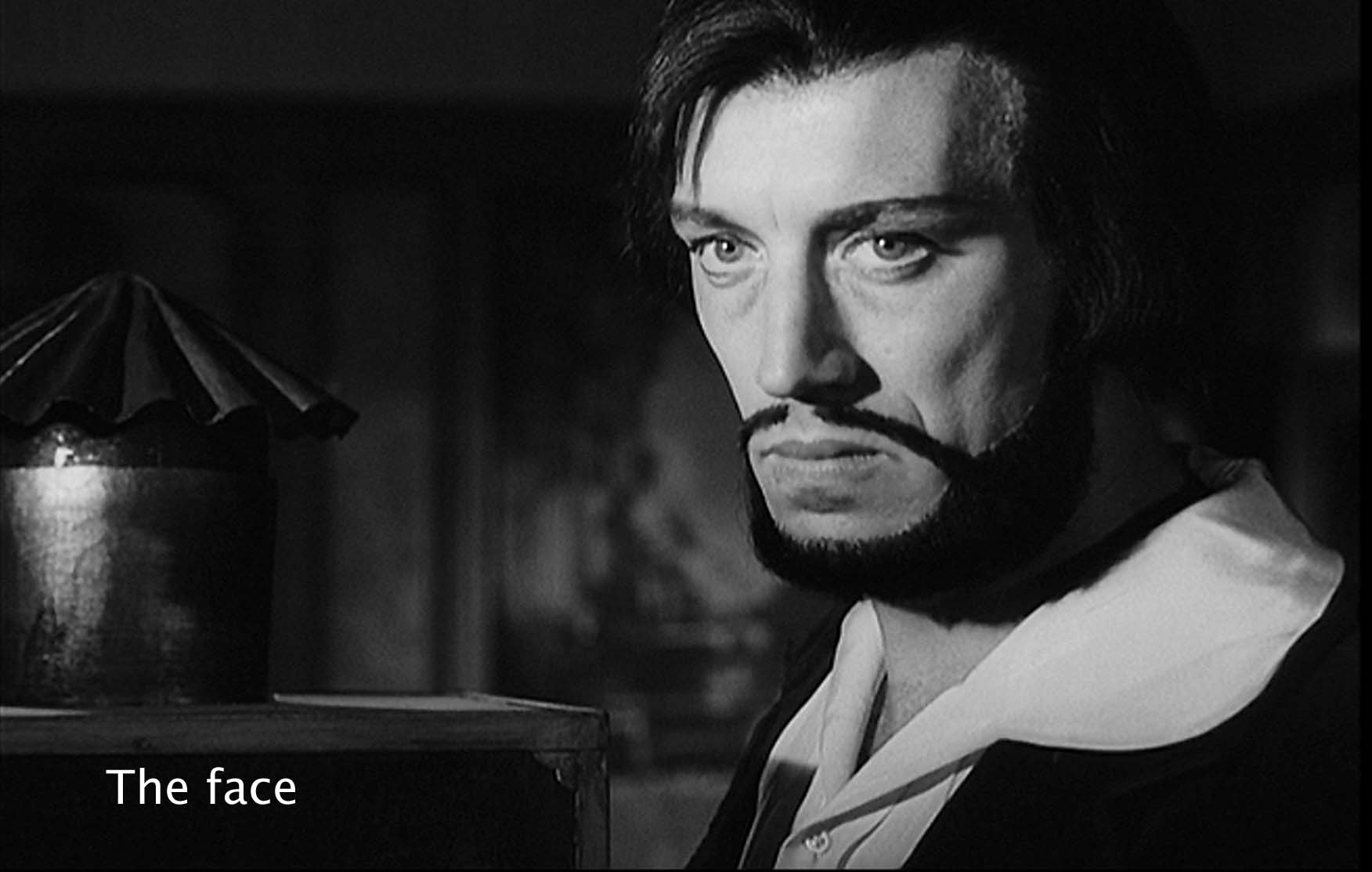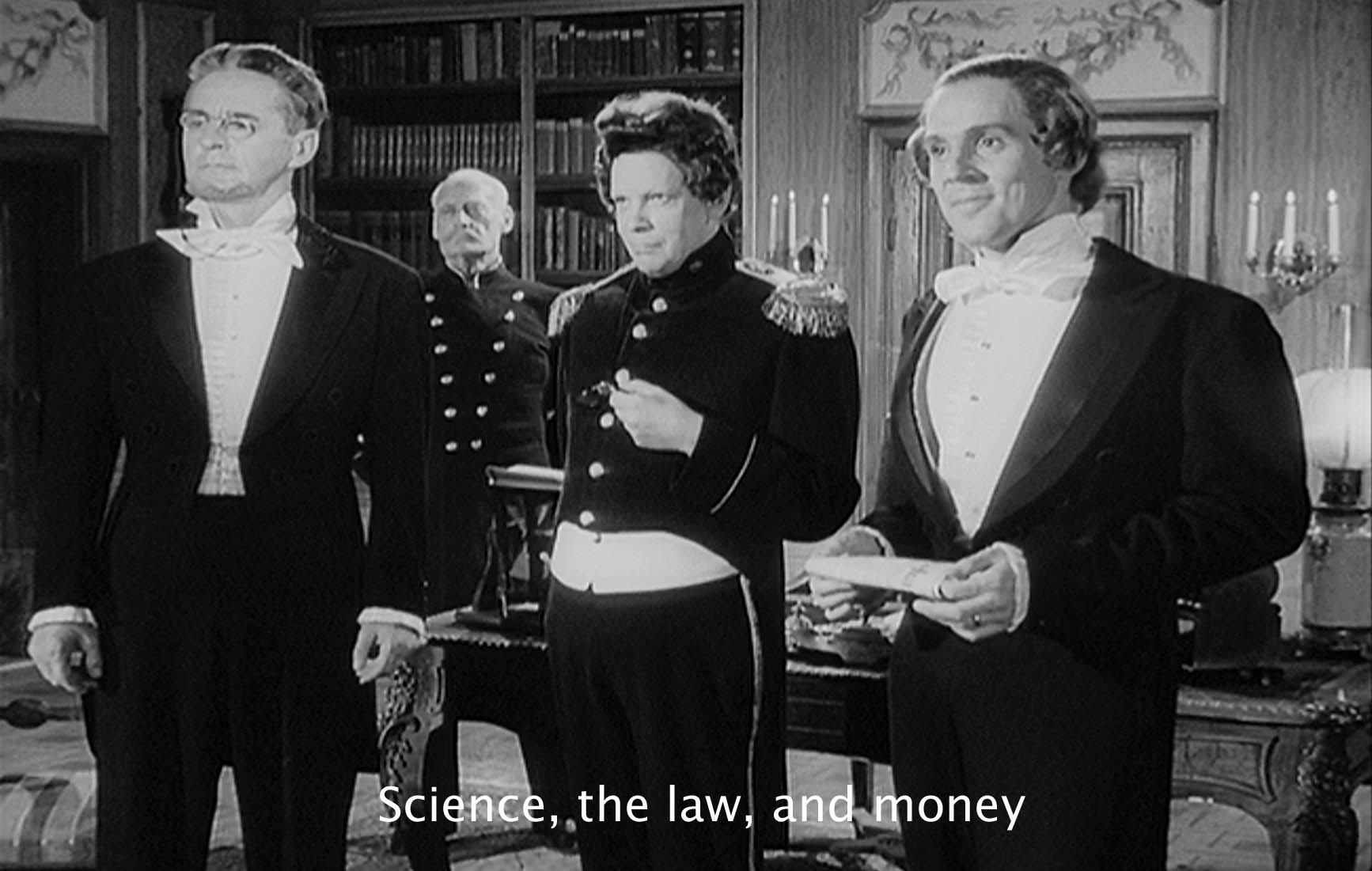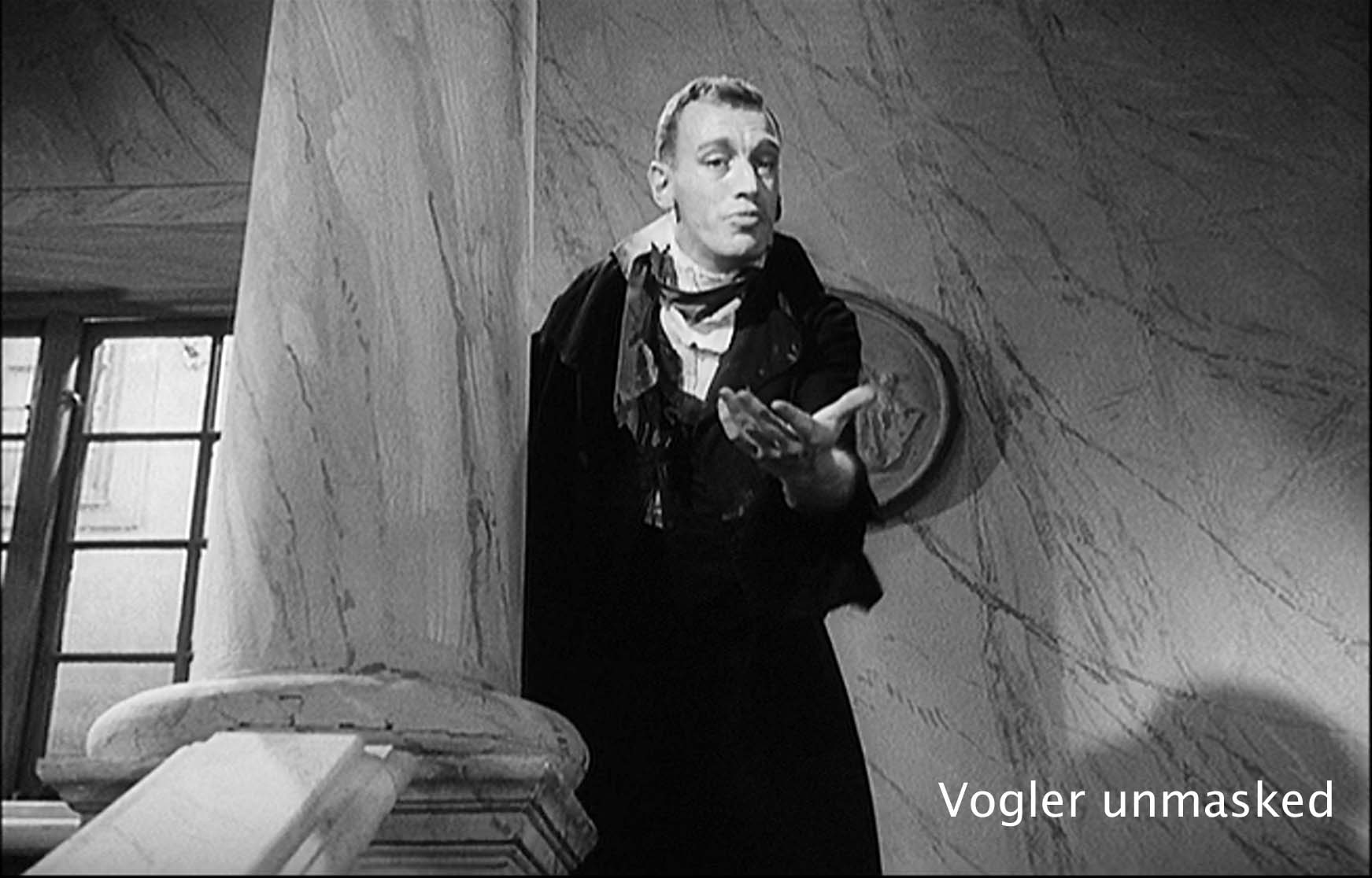Most critics talk about The Magician as dealing with the artist’s relation to his or her audience. The film shows us a quack mesmerist, Albert Emanuel Vogler, who once had the healing powers he still professes—and he may still have them. As in other films, Bergman moves between symbolic dream-level and realistic plot, and most viewers find that hard to follow. He uses an unreal donnée which merges the two levels from the start—as, I suppose, art itself does.
The central idea of the movie is more exactly, I think, an audience’s and an artist’s shared relation to illusion and reality. The film’s Swedish name, Ansiktet, means “face,” and the face of the excellent Max von Sydow, playing the mesmerist, is one of the film’s most striking features, one of its many illusions. The magician dare not appear ordinary to his illusion-hungry public, so he wears eerie make-up that makes him look like “a cross between Rasputin and Fu Manchu” (Geoffrey McNab). He also pretends to be mute, adding to his mysteriousness. Yet he has a perfectly ordinary face when we finally see it halfway through the film, and he can speak—when he is being a man instead of an artist.
The picture begins with close-ups of the magician traveling in a small coach with his troupe, an odd-looking assistant called Aman (played by one of Bergman’s favorite stars, Ingrid Thulin), an old crone, Vogler’s grandmother (the wonderful Naima Wifstrand), a coachboy (Lars Ekborg), and a barker (Åke Fridell), all familiar faces from other Bergman films, actors Bergman was working with at the Malmö City Theater. They are driving (in the 1840’s) through a magnificently spooky forest, traditionally haunted by demons and ghosts. Hearing cries, they stop and bring into the coach an actor dying of drink. As he dies, he shows his face to the mesmerist as the ultimate truth.
This opening episode, the actor’s death, sets up one “fact” against which the rest of the picture, an illusion about illusions, is poised. Death is the final reality; man is an actor whose life, “step after step . . . proceeds into the dark.” All that man considers real are merely roles he plays, fakes, illusions, with two exceptions that the rest of the film develops. Death is one.
After the dark wood of perhaps reality, perhaps the supernatural, as seen from the confining space of the coach, the troupe proceeds to Stockholm. There the authorities detain the coach and its people. The authorities are the foreshortened representatives of science, culture, and the law: the Royal Medical Counselor, Vergérus (Gunnar Björnstrand), a spiritually inclined aristocrat (Erland Josephson—two favorites of Bergman), and the police chief (Toivo Pawlo), respectively if not respectfully. Because of Tubal’s claims that include Vogler’s curing the sick, the authorities intrusively and insultingly examine Vogler (like predecessors of the Federal Drug Administration). From the doctor’s positivist and materialist stance ("Science can penetrate all mysteries”), they humiliate the mute mesmerist, Vogler (literally, the bird-catcher). Vergérus, having found no reason for Vogler’s mutism, says ominously, “I would like to make an autopsy of you.” And he will.
The authorities humiliate the “scientist” by sending the troupe down to the servants’ quarters to eat. In that world, less concerned with illusion and reality, flirtations and sex ensue. That is the second reality against which illusions are poised: sex and love.
During the night, however, either with or without the troupe, it becomes clear that people want to be deceived, to project their own dreams onto the illusionists. The aristocrat’s wife (Gertrud Fridh), grieving for her dead child, tries to seduce Vogler. The supposedly dead actor reappears and dies. His death before was an illusion. This time it’s real. A serving-girl (Bibi Andersson) falls in love with the mesmerist’s inept coachboy despite (or because of?) a fake but intoxicating love-philtre). The sex-starved cook persuades the barker that he should come and live with her and be a preacher. (Presumably, in Bergman’s world, preaching is another kind of show business and illusion.) The arrogant doctor tries to seduce the magician’s assistant, Aman, when he finds out she is Vogler’s wife Manda (another illusion). The police chief simply gets drunk, and his toupee (excuse me, hair-piece) slides off. This too, in its humble way, creates an illusion.
Mixed in with the illusions of these particular characters, Bergman has ransacked mythology for the archetypal images or illusions of the race: the dark wood, the hanged man, death and resurrection, an androgyne, a love goddess, ghosts, the bacchanal, the coffin, the spells and prophecies of the old crone, and the figure of Christ as expressed in Vogler’s tragic mask. As in other Bergman films, notably Wild Strawberries and Smiles of a Summer Night, he provides a triple goddess: the crone (Granny, who really does seem to have supernatural powers); the mother (the aristocrat’s grieving wife); and a (perhaps) virgin (the serving-maid Sara). There is at least one image that speaks for Bergman himself, a magic lantern (which he has written again and again was the most important toy of his childhood). Curiously, although talked about, it plays no part in the illusions to come.
After the complications and accompanying thunderstorm of the night, the troupe puts on its show for the censors the next morning. The first trick, a levitation that fails, is outrageously phony, much to the glee of the skeptics. People like to be deceived, but only if they know they are being deceived; no mysteries, please! Then Vogler, angered, does real tricks: first with the mind, making the police chief’s wife blurt out under hypnosis the less savory aspects of their relationship; then with the body, binding a hefty coachman with invisible (hypnotic) chains. Suddenly, when released, the enraged coachman kills (or seems to kill) the hypnotist. Both these tricks create illusions, but they also dispel illusions. They reveal the falsities of the commissioner’s marriage and the fact that the coachman’s threatening strength is defeated by the weakness of his mind.
Then Vogler plays his deadliest trick—with the soul. Dr. Vergérus brutally insists on an autopsy which he completes to his satisfaction. Locked alone in the dark attic, he suddenly finds an eye in his inkwell, a hand on his papers. (Eye and hand are what the artist-filmmaker uses.) Finally he is pursued all through the attic in a marvelously gothic sequence by the body he has just dissected. (It turns out that the vengeful Vogler had substituted the dead actor’s body and carried off the rest with hypnotism.) Here again Vogler dispels illusion by creating it. Now it is the doctor’s materialist belief.
Nevertheless, despite these “real” illusions and the coachman’s hanging himself, the skeptics remain sublimely unconvinced. The doctor who had been scared out of his wits dismisses Vogler’s death-and-resurrection by saying he had merely created a “little fear of death.”
Vogler without his make-up tries, unsuccessfully, to beg money from his hosts. Just as the skeptics are about to punish Vogler and his wife for fraud (they now appear without make-up or costume as the shabby, troubled people they are), Bergman tacks on the grandest illusion of all, a splendidly improbable ending. Granny deserts the troupe (but gives money to Aman/Manda, and Tubal deserts as well, having become the cook’s frequently-used sex toy. In pouring down rain, Vogler and Aman sit glumly in their coach, hoping not to be arrested. But! as at the end of The Threepenny Opera Victoria’s messenger comes riding, riding, now in bright sunlight a message comes from the king (surely the same king as in Tartuffe) summoning the troupe to a command performance (and thereby humiliating the three tormentors).
Bergman, by this jolly ending, shows that we, too, his audience, want to be deceived (but not deceived) just as the skeptics did. Death and love, the actor’s death and Vogler’s and Manda’s love, the serving-maid’s for the coachboy, even the cook’s for Tubal, these, Bergman seems to say, are the only realities. All other human activity, artist’s or scientist’s or police chief’s, is an illusion, a role played by dying actors.
Perhaps Vogler-Bergman creates realities as well. As Vergérus accuses him, he is both a magician or fraud who creates illusions and “Doctor” Vogler who practices as a physician and heals people. That is, he dispels illusions, as in his hypnotic tricks. (Do the arts make us better people? I wonder.) Tubal, himself a spieler who creates illusions, insists on the physician aspect, that was once valid. Granny’s spells and omens work, but are at the same time phony. The police commissioner’s wife tells truth under hypnosis. The finale, Vogler unmasked, ends the illusions, only to bring in a new one, the miraculous command from the king.
People usually read this film as about the relationship the artist has with his audience, and that is certainly true. But Vogler practices a particular kind of art. He creates illusions that dispel illusions. He is, with his magic lantern show, a filmmaker. He creates illusions as Bergman himself does. This movie is intensely about Bergman and, I am sorry to say, the way he thinks of his relation to his audience.
Here, Vogler’s skeptical audience longs for the illusion but fears the inexplicable. The aristocrat has wagered that “intangible and inexplicable forces really exist,” while Vergérus says, “it would be a catastrophe if scientists were suddenly forced to accept the inexplicable.” “Logically we would have to conceive of . . . “ and the aristocrat supplies, “A God.” So long as Vogler does a levitation that does not work, he is harmless. But after he terrorizes Vergérus in the attic, after dispels illusions, after he raises the possibility of a real supernatural, but reveals himself as ordinary, even pitiable, then he must be clapped in jail.
We ask the filmmaker to deceive us, to show us other illusions. So long as he makes it clear that they are only illusions, they excite us, they make life seem even realer. As the dead actor says, “I didn’t feel really dead until I became a ghost.” But if the filmmaker shows us the “real unreality” he knows, a real miracle, if he breaks down our illusion that we have succeeded in parting reality from unreality, then we simply deny him. We shut the “ghost” up in a coffin. To admit such a “real unreality” would show us that life itself and all we take for real is at least partly fake. This is this magician’s secret power—and Bergman’s, who has called himself a conjuror working with a gimmick that makes us think still pictures move. Only woman (the mother or the crone-goddess who gives the mesmerist his powers) can create real life that is not an illusion. Bergman, and all filmmakers, by extension, all artists, are but tricksters.
Bergman, it seems to me, shoots with one foot in existentialism and the other in Jung’s collective unconscious. Basic to his sensibility is the idea that death is an ultimate reality and we live life (even love) by consciously accepting life as brief and illusory. As he himself expresses it, “Each film is my last.”
Mixed with this dark view is small cheer from Jung’s version of psychoanalysis, the concept of woman as life-bearer and man as abstraction-mongerer (with a big hat), the concept of the filmmaker as a dream-peddler, and a preoccupation with the characters’ spying on the lovemaking of others, primal scene fantasies, which, Freudian analysts say, one would expect to find at the heart of the psyche in both filmmaker and filmgoer. In sum, Bergman’s sensibility pivots about one central and eminently cinematic issue: What is real, or, put another way, What are you seeing?
People have trouble reading Bergman’s films because they are full of images unconnected to plot. This style stems from his essentially visual theme of illusion or imagination. But Bergman’s technique takes less from the ideological montages of Eisenstein, Dovshenko, and the Russian school than from the surrealism of Vigo, Cocteau, Hans Richter, and Buñuel He has also drawn heavily on Swedish tradition, notably the expressionism of Strindberg whom he has often staged. Though his earlier models are heavily psychological, Bergman is also mythological. He draws from folklore and such primitive art-forms as the puppet-play, the commedia dell’arte, medieval woodcuts, mystery plays, cartoons, and the films of Méliès.
More important, Bergman has added his own existentialist touches, which most obviously take form as his extensive use of close-up and his “confined-space” technique (which he first developed in Waiting Women in 1952). Here he gives us the coach, the attic, and a very cozy laundry-basket. The confined space makes for lots of close-ups: “Our work in films [he has written] begins with the human face. We can certainly become completely absorbed in the esthetics of montage, we can bring together objects and still life into a wonderful rhythm, we can make nature studies of astounding beauty, but the approach to the human face is without doubt the hall-mark and the distinguishing quality of the film.”











